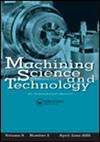走向绿色电火花加工:技术现状与展望
IF 2.6
4区 工程技术
Q2 ENGINEERING, MANUFACTURING
引用次数: 2
摘要
摘要放电加工工艺可用于高精度制造复杂形状的零件;然而,它具有不友好的环境影响,如有毒排放和健康危害;这些影响与最近绿色工业环境的趋势不一致。如今,研究人员、从业者和设计师专注于实施基于可持续EDM的绿色环保原则。因此,本文全面概述了大多数增强和环保技术,以提高电火花加工工艺的效率(材料去除率、较低的电极磨损率和表面粗糙度)并降低对环境的影响。这些增强技术被分为四个驱动因素。讨论了每种技术的优点和局限性。然后,通过技术准备水平来评估每项技术的成熟度。亮点EDM技术正处于成熟阶段。在过去的10年中,主要的研究贡献是。最成熟的技术是低温处理、混合EDUVM和PMEDM技术。CNT混粉电火花加工技术和增材制造技术已成功应用于粗加工过程,我们期待着更多的工业应用。混合EDAM技术的高能耗限制了其成熟度,因此有必要进行进一步的研究,以找到一种在工业上可行的工艺。本文章由计算机程序翻译,如有差异,请以英文原文为准。
Toward green electrical discharge machining (EDM): state of art and outlook
Abstract The electrical discharge machining process is useful to manufacture complex shaped parts with high accuracy; however, it has unfriendly environmental impacts such as toxic emissions and health hazards; these impacts do not align with the recent orientation toward green industrial environments. Nowadays, researchers, practitioners, and designers focus on implementing sustainable EDM-based green environmental principles. Thus, this article presents an extensive overview of most of the enhancement and eco-friendly technologies for improving the efficiency of the EDM process (material removal rate, lower electrode wear ratio, and surface roughness) and lowering the environmental impacts. These enhancement technologies have been classified into four drivers. The advantages and limitations of each technology have been discussed. Then, the maturity of each technology has been estimated through technology readiness levels. Highlights EDM technology is in its maturity stage. The main research contributions in the last 10 years are on. The highest mature technologies are the cryogenic treatment, hybrid EDUVM, and PMEDM technologies. The CNT powder mixed EDM and the additive manufacturing technologies have been successfully applied in roughing processes and we expect more industrial applications. The high energy consumption with hybrid EDAM technology is nowadays limiting its maturity therefore further research is necessary to come to an industrially viable process.
求助全文
通过发布文献求助,成功后即可免费获取论文全文。
去求助
来源期刊

Machining Science and Technology
工程技术-材料科学:综合
CiteScore
5.70
自引率
3.70%
发文量
18
审稿时长
6 months
期刊介绍:
Machining Science and Technology publishes original scientific and technical papers and review articles on topics related to traditional and nontraditional machining processes performed on all materials—metals and advanced alloys, polymers, ceramics, composites, and biomaterials.
Topics covered include:
-machining performance of all materials, including lightweight materials-
coated and special cutting tools: design and machining performance evaluation-
predictive models for machining performance and optimization, including machining dynamics-
measurement and analysis of machined surfaces-
sustainable machining: dry, near-dry, or Minimum Quantity Lubrication (MQL) and cryogenic machining processes
precision and micro/nano machining-
design and implementation of in-process sensors for monitoring and control of machining performance-
surface integrity in machining processes, including detection and characterization of machining damage-
new and advanced abrasive machining processes: design and performance analysis-
cutting fluids and special coolants/lubricants-
nontraditional and hybrid machining processes, including EDM, ECM, laser and plasma-assisted machining, waterjet and abrasive waterjet machining
 求助内容:
求助内容: 应助结果提醒方式:
应助结果提醒方式:


